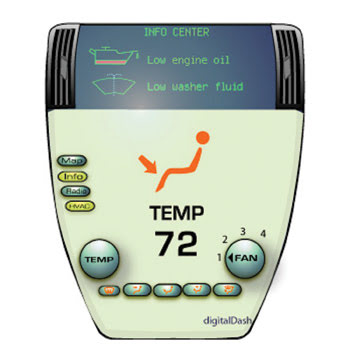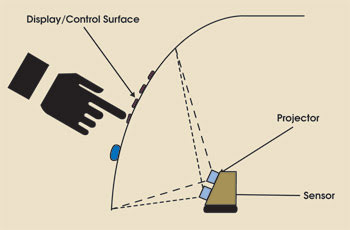An optically based prototype customizable display integrates telematics, video and common controls to enhance driver information.
Tim D. Pryor Jr., Digital Dash Ltd.
One problem with using display technology such as LCDs to relay necessary information to a driver is that some controls benefit from or even require physical knobs and dials. These can be difficult or impossible to integrate with some types of displays.
However, a control interface called the reconfigurable tactile display from Digital Dash Ltd. of Montreal incorporates real knobs, buttons and sliders onto a screen for the driver’s display (Figure 1). Software-driven, electro-optically based, it employs a solid-state camera to project an image from behind the dashboard onto a screen for viewing. The concept, which is in the early stages of development, mixes projection display and machine vision technology with controls for an unusual human-machine interface. The image might be a map or the usual automobile controls, such as radio volume or air conditioning.

Figure 1. Images on the dashboard can take the form of standard displays or can be combined with physical controls such as knobs, sliders and buttons.
The projector displays text and graphics, and a sensor reads changes in the controls, such as when the driver turns up the heat. The image is displayed on a surface, which, in the prototype, is a beaded rear-projection film that is applied directly to the dashboard to enhance the contrast of the display.
To customize the dashboard, the projector can display images through a clear control. For instance, a knob can have a label displayed directly on its face, and that label can change as the device changes. If, for example, the driver called up the heat control, the labels on the knobs and buttons would correspond to heat and air-conditioning controls. If the driver changed the display to the radio or CD, the real controls would be labeled accordingly.

Figure 2. The reconfigurable tactile display consists of a projector, a camera or sensor that takes an image of the controls, changing state and the finger touching the screen, and a display and control surface.
The main technological challenges to moving this prototype forward include projector brightness and screen optical design, which involves finding a screen that can provide good contrast and brightness. The designers are looking at laser projectors and LED-based microprojectors, which will meet the lifetime requirements for an automotive application.
Laser projectors have the advantage of being in focus regardless of the curvature of the dashboard. A sensor also can be incorporated in a laser-scanning device to sense when a person is manipulating the controls. LED projectors have a few drawbacks, including the fact that they need a lens, which makes them more expensive and not as customizable for a given display surface. And they may not be able to handle the curve of the dashboard as well as a laser.
But LED projectors are brighter than the laser variety and readily available — whereas laser projectors are still in the prototype phase. Current prototypes of the tactile display system use an LED projector, and the designers predict that they will be incorporating laser projectors by the year 2010.
Meet the author
Tim D. Pryor Jr. is project manager at Digital Dash Ltd. in Montreal; e-mail: [email protected].